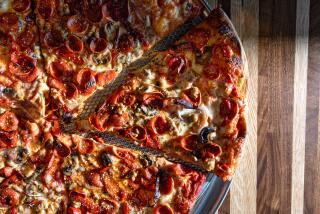Cooking Up a Glossary of Terms
- Share via
The following microwave glossary will help keep the language of microwaving from becoming as impenetrable as computerese.
Active cookware: Containers designed to attract microwave energy so that they crisp and/or brown food. Examples are browning dishes and grills and new materials used to package foods like popcorn or crisp-crusted frozen foods such as pizza.
Arcing: Sparks or electric flashes inside a microwave oven. They produce intense heat that can damage the oven and the containers put into it. Arcing occurs when metal devices are used. Metal skewers, metal clamps (the sort found on poultry), even twist-ties containing metal can cause arcing. Small foil strips may be used safely to shield areas of food that are cooking too fast; and small foil containers can be used if they’re lightweight, no more than three-quarters-inch deep and at least three-quarters full of food.
Browning agents: Because chops, chicken parts and other small cuts rarely brown in a microwave oven, they’re often colored with bastes, either commercial preparations or those you mix yourself. Most popular are half-and-half mixtures of water and liquid gravy browner, soy sauce or Worcestershire sauce. For best results, brush the food with the browner before microwaving, then again at half time.
Carousel ( or turntable) : Lazy Susan-type discs that rotate food slowly as it microwaves to ensure even cooking. Some microwave ovens have built-in turntables, but battery-powered or wind-up models are also available.
Carry-over cooking: Foods continue to cook for some minutes after being removed from the oven and this standing time is called “carry-over cooking.”
Density: The relative solidity or porousness of food. Light, porous foods cook faster than heavy, dense ones.
Doughnut-fashion: To arrange food in a ring around the edge of a container to ensure faster, more uniform cooking.
Hot spots: Nearly every microwave oven has areas called “hot spots” where foods cook faster than at others. It’s important not to position delicate foods such as custards or egg-thickened sauces in these areas. Turntables and other refinements help minimize hot spots; still, nearly every oven has them.
To test for hot spots, cover the oven floor with slices of bread, letting the crusts touch. Microwave, uncovered, on HIGH (100% power) five to seven minutes, or until the bread begins to toast. Wherever the bread is most brown, the oven has a hot spot.
Load: The amount of food to be microwaved at one time. The bigger the load, the more slowly the food will cook. One potato, for example, will bake in four to five minutes but eight will require 20 to 24 minutes.
Magnetron: The part of the oven that converts household current into microwaves. Generally located at the top of the oven, the magnetron funnels microwaves into the oven via a wave guide.
Megahertz: The unit of measure used to calculate the frequency of microwaves. Most microwave ovens operate at 2,450 megahertz, or 2,450 million cycles per second.
Rearrange: Because foods around the edge of a container microwave faster than those in the middle, it’s often necessary to rearrange the foods by moving the items in the center toward the outside.
Rotate: When foods can’t be stirred or rearranged--custards and coffee cakes, for instance--they must be rotated now and then as they microwave so they cook evenly.
Runaway: A term used to describe food that’s cooking much faster in one area than in another. For example, if you heat a jelly doughnut in a microwave oven, the sugar-rich jelly center will bubble ferociously before the doughnut itself becomes hot.
Shield: To cover areas of food (poultry wing tips, fish tails, etc.) that are browning too fast with smooth, thin strips of foil to slow cooking. It’s essential that the strips be no more than two inches wide and that they be smoothed around the food, not just draped on top. Crinkled foil can make the oven arc.
More to Read
Eat your way across L.A.
Get our weekly Tasting Notes newsletter for reviews, news and more.
You may occasionally receive promotional content from the Los Angeles Times.










